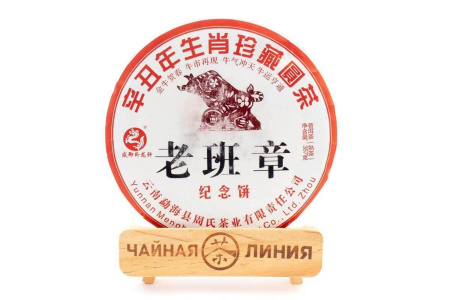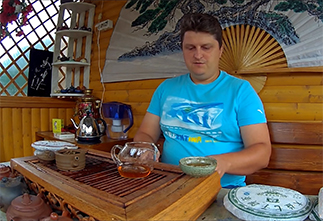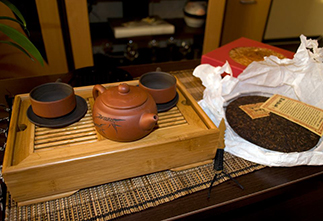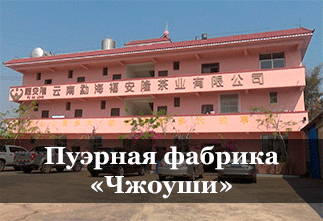Shu Puer "Lao Ban Zhang" 2021 from Zhoushi: Legendary Name, Rich Taste
The name Lao Ban Zhang (老班章, Lǎo Bān Zhāng) is synonymous with the highest quality and prestige in the world of pu-erh. This shu pu-erh (熟普洱, Shú pǔ'ěr), produced in 2021 by the Zhoushi (周氏, Zhōu shì) factory in Menghai County, features raw materials from this legendary terroir. Presented in the standard 357-gram Bìn Chá (饼茶, Bǐng chá) cake form, the tea offers a rich, full-bodied, and energetic experience worthy of its name at an attractive price.
The maker of Zhoushi (周氏, Zhōu shì ) and the legend of Lao Ban Zhang
The Yunnan Menghai County Zhou Shi Tea Industry Co., Ltd. factory is located in Menghai County, the heart of the Xishuangbanna region and one of the most important centers of pu-erh production. The nearby village of Lao Ban Zhang is famous for its ancient tea trees and produces some of the most sought-after and expensive pu-erhs in the world, distinguished by their power and complexity.
The use of the name "Lao Ban Zhang" for shu puerh means that high-quality raw materials (maocha) collected from this famous region were used for its production. The excellent raw materials of Lao Ban Zhang should give the chu a special depth, density and richness of taste.
Vintage 2021 and appearance
The tea was pressed in 2021, which gives it an age of 4 years today. This is a moderate age for Shu Puer - it is already quite smoothed out, but still fresh and full of energy. Puer has a dense cake pressing, a bright and very rich taste from the first infusion, capable of brewing to the state of oil, which is typical for high-quality shu.
Aroma: from dough and nuts to cognac and bread
The aromatic profile of this tea is complex and develops over the course of tea drinking:
- Dry leaf: Gives the aroma of salt dough or a handful of fresh nuts.
- Heated leaf (in a gaiwan): Reveals the scent of honey and nuts.
- Infusion (first infusion): Notes of cognac, nuts and black bread appear.
Taste: palette from chocolate to honey
The taste of this shu puer is rich and dynamic:
- Development: The flavour palette expands from nutty-chocolate to creamy-honey as you steep.
- Aftertaste: Has a pleasant bready aftertaste.
- Overall impression: Fresh, tasty, decent tea. It is important to rinse the tea well, as it opens up over time.
Energy and effect
This shu puer has a noticeable effect:
- Strength: The effect is felt after the first cup.
- Energy: The blood gets moving, you can instantly feel the heat and surge of strength.
- Purpose: Perfect for starting the day.
Brewing recommendations
Considering the dense pressing and richness of the tea:
- Utensils: Gaiwan is recommended for better control of the brew.
- Quantity: Standard 5-8g per 100-150 ml is quite suitable.
- Washing: It is necessary to wash the tea well (1-2 times).
- Water: Boiling water (95-100°C).
- Brewing: By pouring. Start with short exposures, as the infusion quickly becomes saturated. The time can be gradually increased.
Shu puer "Lao Ban Zhang" 2021 from the Zhoushi factory is an intriguing tea that bears the name of one of the most prestigious puer terroirs. The tea creates a portrait of a dense, rich, tasty shu with a rich, developing profile (nuts, chocolate, cream, honey, cognac, bread) and a strong, invigorating effect. Despite its moderate age, it already gives vivid impressions and is perfect for morning tea. An attractive price makes it an affordable way to touch the magic of the name "Lao Ban Zhang" in the format of shu puer.
|
Name in Chinese
|
老班章 |
|
Pinyin
|
lǎobānzhāng |
|
Country
|
China |
|
District
|
Xishuangbanna Dai Autonomous Prefecture |
|
Provinces
|
Yunnan (云南) |
|
Manufacturer
|
Чжоуши (周氏) |
|
Year of pressing
|
2021 |
|
Pressing form
|
Bing Cha (Cake Tea) |
|
Declared weight, g
|
357 |
- Комментарии
- Вконтакте
Pu-erh is one of the most unique types of tea, which only gets better with age. Many people, when they first encounter this tea, wondered: why is pu-erh more often found in pressed form (cakes, bricks, tochas), and not in loose form? The reasons for this are related to both history and the practical aspects of storing and fermenting tea. Despite modern technologies that allow the production of loose pu-erh, the shape of pressed cakes remains unchanged. And pu-erh is more often found on sale in pressed form, for example, in the form of cakes or bricks, and loose pu-erh is less common. We will talk about the reasons for pressing pu-erh into cakes in this article.
Puer is a unique Chinese tea that is distinguished by its depth of taste, complexity of aromas and versatility of aftertaste. Its taste characteristics are formed under the influence of many factors, from growing conditions to the brewing method. Let's look at the main ones.
The question often arises: how to brew puerh correctly? Sometimes the phrase "to get high" is added to it. Moreover, everyone has their own understanding of this phrase. Some mean vigor, and some - intoxication. So how to brew puerh tea correctly? Let's consider several options.
Traveling through the tea mountains, we found ourselves in another land of blue roofs - the village of Zhongcai, which is located in the Menghai district of Yunnan province. According to tradition, we were shown another local tea tree, which, according to the Chinese, is at least a million years old :) The village is very authentic, not designed for tourists, there are many wild pu-erhs there and, of course, we were warmly received. They treated us to local cuisine and tea. We also asked the residents about the prices of tea and how they have changed in recent years.
Well, finally we got to the Zhoushi puer factory, which is located in Menghai, Yunnan Province. We first purchased their cakes remotely several years ago and they were to the taste of Russian tea people. Now it's time to personally meet the owners and expand the range of this brand on the shelves of ChL. In this video, you will see the production process of the already familiar cakes, rare shots of the nuances of packaging and the atmosphere of such places.
The tea ceremony occupies a special place in the centuries-old Eastern tradition. And although the essence of this phenomenon remains constant, the nature and external manifestations of the tea ceremony in different nations have their own national characteristics. In each Chinese province, the tea ceremony and the tea used in it are varied: for example, residents of the southern provinces prefer green tea, and residents of the northern provinces - red tea, in Fujian province they more often use Oolong tea, and in Yunnan province Puer tea is widely known.


























































































